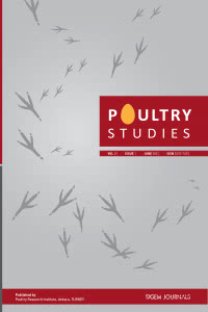Broylerlerde Florür Toksikasyonunun Duodenum, Jejunum ve Ileum üzerine Etkisi
Flor toksikasyonu, ince bağırsak, asetilkolin
The Effect of Fluoride Toxication on Duodenum, Jejunum and Ileum of Broilers
___
- Cronin, S., Manoharan, V., Hedley, M. and Loganathan P., 2000. Fluoride: A review of its fate, bioavailability, and risks of fluorosis in grazed‐pasture systems in New Zealand. New Zealand Journal of Agricultural Research, 43(3):295-321.
- Dhar, V., Bhatnagar, M., 2009. Physiology and toxicity of fluoride. Indian Journal of Dental Research, 20(3):350.
- Shupe, JL., Olson AE., Sharma, R.,1972. Fluoride toxicity in domestic and wild animals. Clinical toxicology, 5(2):195-213.
- Whelton, HP., Ketley, CE., McSweeney, F., and O'mullane, DM., 2004. A review of fluorosis in the European Union: prevalence, risk factors and aesthetic issues. Community dentistry and oral epidemiology, 32(s1):9-18.
- Khairnar, MR., Dodamani, AS., Jadhav, HC., Naik, RG., and Deshmukh MA., 2015. Mitigation of fluorosis-a review. Journal of clinical and diagnostic research: JCDR, 9(6):ZE05.
- Choi, AL., Sun, G., Zhang, Y., Grandjean, P., 2012. Developmental fluoride neurotoxicity: a systematic review and meta-analysis. Environmental health perspectives, 120(10):1362.
- Shivarajashankara, Y., Shivashankara, A., Bhat, PG., Rao, SH., 2001. Effect of fluoride intoxication on lipid peroxidation and antioxidant systems in rats. Fluoride, 34(2):108-13.
- Buzalaf, CP., de Lima Leite, A., Buzalaf, MAR., 2015. Fluoride metabolism. In: Preedy VR, editor. Fluorine: Chemistry, Analysis, Function and Effects. Food and Nutritional Components in Focus No. 6 UK: The Royal Society of Chemistry, p. 54-72.
- Liu, J., Cui, H., Peng, X., Fang, J., Zuo, Z., Wang, H., 2013. Dietary high fluorine induces apoptosis and alters Bcl-2, Bax, and caspase-3 protein expression in the cecal tonsil lymphocytes of broilers. Biological trace element research, 152(1):25-30.
- Dasarathy, S., Das, TK., Gupta, IP., Susheela, AK., Tandon, RK., 1996. Gastroduodenal manifestations in patients with skeletal fluorosis. Journal of gastroenterology, 31(3):333-7.
- Luo, Q., Cui, H., Peng, X., Fang, J., Zuo, Z., Liu, J., 2012. Intestinal oxidative stress in broilers caused by high dietary fluorine. Fluoride, 45(4):349-56.
- Gharzouli, K., Amira, S., Khennouf, S., Gharzouli, A., 2000. Effects of sodium fluoride on water and acid secretion, soluble mucus and adherent mucus of the rat stomach. Canadian Journal of Gastroenterology and Hepatology, 14(6):493-8.
- Girgis, G., Barta, J., Brash, M., Smith, T., 2010. Morphologic changes in the intestine of broiler breeder pullets fed diets naturally contaminated with Fusarium mycotoxins with or without coccidial challenge. Avian diseases, 54(1):67-73.
- Bulbul, T,, Bozkurt, Z., Ulutas, E,, Yilmaz, O,, Bulbul, A., 2013. The effect of L-arginine on growth performance, some serum biochemical parameters and duodenal motility in broilers. Kafkas Universitesi Veteriner Fakultesi Dergisi, 19(5):821-7.
- Klasing, KC., 1998. Comparative avian nutrition: Cab International.
- Gayer, CP., Basson, MD., 2009. The effects of mechanical forces on intestinal physiology and pathology. Cellular signalling, 21(8):1237-44.
- Vantrappen, G., Janssens, J., Coremans, G., Jian, R., 1986. Gastrointestinal motility disorders. Digestive diseases and sciences, 31(9):5-25.
- Nopakun, J., Messer, HH., Voller, V., 1989. Fluoride absorption from the gastrointestinal tract of rats. The Journal of nutrition, 119(10):1411-7.
- Pain GN., 2017. Pain in the Gut Fluoride Damage to the Gastrointestinal Tract.
- Ohama, T., Hori, M., Ozaki, H., 2007. Mechanism of abnormal intestinal motility in inflammatory bowel disease: how smooth muscle contraction is reduced? Journal of Smooth Muscle Research, 43(2):43-54.
- Ozaki, H., Hori, M., Kinoshita, K., Ohama, T., 2005. Intestinal dysmotility in inflammatory bowel disease: mechanisms of the reduced activity of smooth muscle contraction. Inflammopharmacology, 13(1):103-11.
- Vermillion, DL., Huizinga, JD., Riddell, RH., Collins SM., 1993. Altered small intestinal smooth muscle function in Crohn's disease. Gastroenterology, 104(6):1692-9.
- Follin-Arbelet, B., Moum, B., 2016. Fluoride: a risk factor for inflammatory bowel disease? Scandinavian journal of gastroenterology, 51(9):1019-24.
- Luo, Q., Cui, H., Peng, X., Fang, J., Zuo, Z., Deng, J., 2013. Suppressive effects of dietary high fluorine on the intestinal development in broilers. Biological trace element research, 156(1-3):153-65.
- Svihus B., 2014. Function of the digestive system1. The Journal of Applied Poultry Research, 23(2):306-14. doi: 10.3382/japr.2014-00937.
- Yildirim, E., Aktuna, Z., Yalcinkaya, I., Eraslan, G., Kanbur, M., Aydos, TR., 2013. The Smooth Muscle Contractılıty in Aflatoxıcated Broıler Chıcken Ileum. Fresenıus Envı
- ISSN: 1302-3209
- Yayın Aralığı: 2
- Başlangıç: 1999
- Yayıncı: Tavukçuluk Araştırma Enstitüsü Müdürlüğü
Olugbenga Adeniran OGUNWOLE, Iretioluwa Adenike OLUDOYI, Akinola Yinka Paul OJELADE
Olugbenga Adeniran OGUNWOLE, Iretioluwa Adenike OLUDOYI, Akinola Yinka Paul OJELADE
Türkiye’de Tavuk Eti Tüketiminde Etkili Olan Sosyo-Ekonomik Faktörlerin İncelenmesi
Kebede Senbeta EWONETU, Asefa KASAYE
Diyarbakır İli Köy Tavukçuluğunun Yapısı
Hakan İNCİ, Muhammed Ali EKİNCİ, Ersin KARAKAYA, Büyamin SÖĞÜT, Tugay AYAŞAN
Kebede Senbeta EWONETU, Asefa KASAYE
Omolade A. OLADELE, Oluwaseun O. ESAN, Iyabo A. ADETIBA, Ini L. AKPAN, Oluyemisi M. ADEWALE
Hüseyin GÖGER, Şahnur Erdoğan DEMİRTAŞ, Şermin YURTOĞULLARI
Omolade A. OLADELE, Oluwaseun O. ESAN, Iyabo A. ADETIBA, Ini L. AKPAN, Oluyemisi M. ADEWALE
